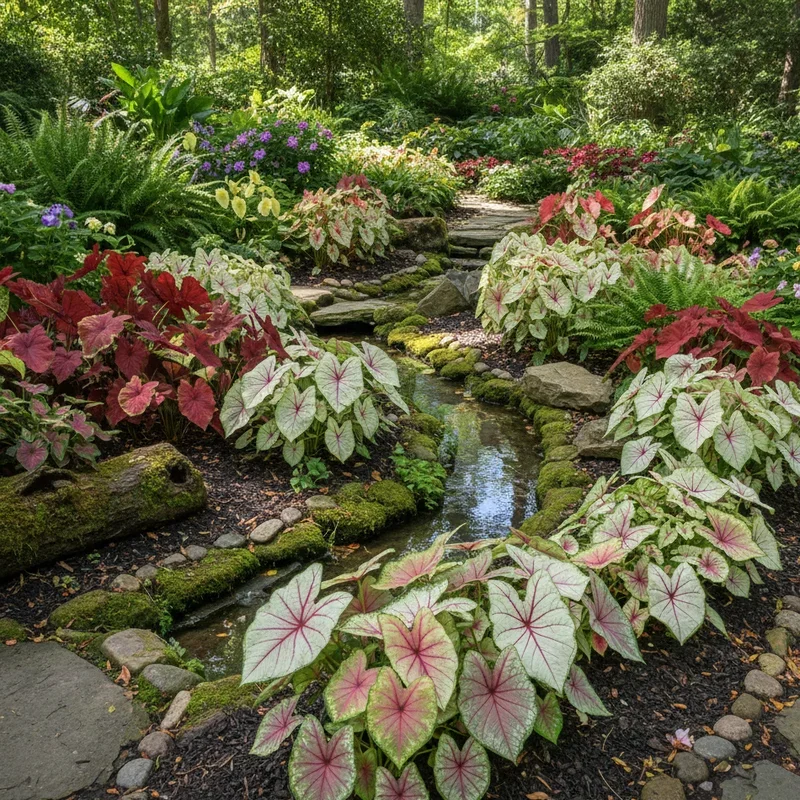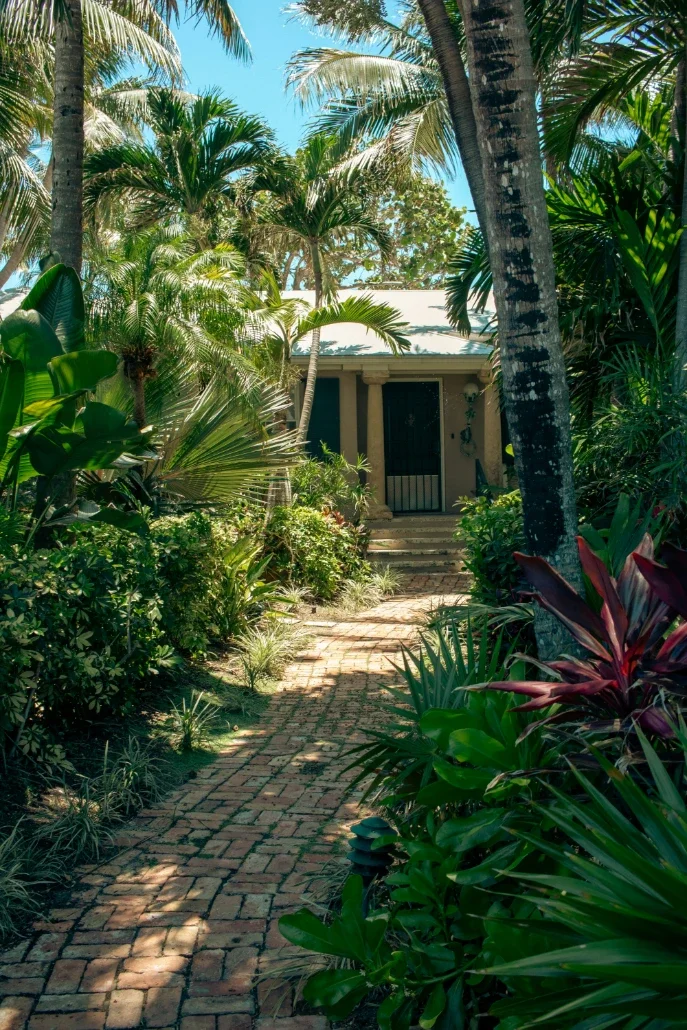15 Caladium Garden Ideas to Brighten Up Your Landscape
Discover 15 stunning caladium garden ideas to transform shady spots into vibrant displays. Create tropical magic with these colorful foliage plants!
Imagine walking through your garden and discovering leaves that look like an artist splashed them with watercolors, creating masterpieces more stunning than any flower could achieve. That's the magic caladiums bring to landscapes, turning ordinary shade gardens into extraordinary galleries of living art. These tropical beauties laugh in the face of conventional gardening wisdom that says you need sun for color. Who needs blooms when you have heart-shaped leaves painted in combinations of pink, red, white, and green that would make Monet jealous? Whether you're battling a gloomy corner under oak trees or seeking to jazz up that boring stretch along your house's north side, caladiums arrive like reinforcements armed with paintbrushes. They're nature's way of proving that sometimes the supporting cast steals the show from the leading flowers. From subtle whispers of color to bold statements that stop visitors in their tracks, these versatile plants adapt to containers, borders, and mass plantings with equal enthusiasm. Ready to discover how these leafy showstoppers can transform your landscape from shadowy afterthought to stunning focal point?
1. Tropical Shade Garden with Mixed Caladium Varieties
Transform your shaded areas into a tropical paradise by combining different caladium varieties that create layers of color and texture. Mix strap-leaved types with fancy-leaved varieties, playing with heights and hues like you're conducting a botanical orchestra. The key lies in selecting cultivars with complementary colors: pair white-centered 'Candidum' with pink-splashed 'Florida Sweetheart' for romantic appeal. You're essentially painting with plants, using their foliage as brushstrokes across your garden canvas. Add elephant ears and hostas for textural contrast that makes caladiums pop even more. The varying leaf sizes create visual rhythm, drawing eyes through the space naturally. This design works particularly well under pergolas or tree canopies where filtered light makes colors glow. Water features enhance the tropical feel while providing the humidity caladiums adore. By midsummer, you'll have created a lush retreat that feels like you've teleported to a rainforest resort.
2. Container Gardens Featuring Caladiums as Centerpieces
Elevate your container game by making caladiums the stars of portable garden shows that brighten patios, decks, and entryways. These dramatic plants serve as living flower arrangements that last all season, not just a few weeks. Choose containers that complement leaf colors: terra cotta for warm reds, glazed blue for whites and pinks. You're creating moveable feasts for the eyes that can follow the shade as seasons progress. Surround caladiums with cascading plants like creeping Jenny or trailing begonias for a finished look. The thriller-filler-spiller formula works perfectly with caladiums taking the thriller role magnificently. Large containers allow for multiple caladium bulbs, creating fuller displays that command attention. This approach lets apartment dwellers and renters enjoy tropical splendor without permanent plantings. Remember to use quality potting mix that retains moisture while draining well for optimal growth.
3. Caladium Border Along Shaded Walkways
Line your shaded pathways with caladium borders that guide visitors through your garden like a red carpet of multicolored leaves. This linear planting creates rhythm and movement, turning mundane walkways into exciting journeys of discovery. Select varieties of similar height for formal looks or mix sizes for cottage garden charm. You're essentially creating living wallpaper that changes as light shifts throughout the day. The heart-shaped leaves seem to wave hello as breezes catch them, adding motion to static spaces. Plant bulbs closer together than recommended for lush, overlapping coverage that hides soil completely. This design particularly suits homes with covered walkways or paths under tree canopies. Edge with low boxwood or liriope for year-round structure after caladiums retreat underground. The border effect works equally well along driveways, creating welcoming approaches that soften hard surfaces.
4. Window Box Displays with Compact Caladiums
Bring color to eye level with window boxes showcasing compact caladium varieties that transform views from both inside and outside. These elevated plantings put the intricate leaf patterns where they're most appreciated, creating living stained glass effects. Choose dwarf varieties like 'Miss Muffet' or 'Gingerland' that won't overwhelm smaller containers or block windows. You're framing your windows with natural artwork that beats any curtain treatment. The proximity to the house provides extra warmth that extends the growing season slightly. Combine with shade-tolerant annuals like impatiens or begonias for additional texture and occasional flowers. This approach works brilliantly for basement windows that need brightening or kitchen windows where you'll enjoy them while washing dishes. Regular watering is crucial since window boxes dry faster than ground plantings. The intimate scale allows you to appreciate subtle color variations you might miss in larger plantings.
5. Poolside Caladium Plantings for Resort Vibes
Create a tropical oasis around your pool with caladiums that thrive in the humid microclimate while adding resort-style glamour. These moisture-loving plants naturally suit poolside conditions, reflecting in the water for doubled visual impact. Choose bold varieties with splashy patterns that hold their own against bright pool tiles and furniture. You're designing a vacation destination in your own backyard, where every day feels like a getaway. Position them where they won't drop leaves directly into the pool but close enough to benefit from splash zone humidity. The large leaves provide textural contrast to typical poolside palms and grasses. This placement particularly suits covered pool areas where shade is abundant. Mix with tropical plants like bird of paradise or canna lilies for authentic resort landscaping. The reflection of colorful caladium leaves in pool water creates an ever-changing art installation.
6. Moonlight Garden with White Caladium Varieties
Design an ethereal evening garden using white caladium varieties that seem to glow in moonlight and twilight hours. These pale beauties like 'Candidum' and 'White Christmas' create ghostly elegance that transforms gardens after dark. The white leaves catch and reflect even minimal light, making paths navigable without harsh lighting. You're crafting a magical space that comes alive when most gardens disappear into darkness. Combine with white impatiens, silver-leaved plants, and white-blooming night-fragrant flowers for complete sensory experience. The monochromatic palette feels sophisticated and calming, perfect for meditation gardens or quiet retreats. This design especially suits entertainment areas where evening gatherings happen regularly. Add subtle uplighting to enhance the luminous quality without overwhelming the natural glow. The effect becomes even more dramatic during full moon nights when the entire garden seems illuminated from within.
7. Caladium and Fern Woodland Combination
Pair caladiums with various fern species to create woodland gardens that feel both wild and intentional. This combination mimics natural forest floors while adding unexpected color to typically green understories. The feathery fern fronds provide delicate texture that highlights caladiums' bold leaf shapes beautifully. You're recreating nature's own design but with an artistic upgrade that she'd surely approve. Japanese painted ferns echo caladium colors while adding silver tones to the mix. The different growth habits create multiple layers that add depth to shade gardens. This pairing works wonderfully under deciduous trees where conditions mirror natural woodland settings. Add native woodland wildflowers for seasonal interest before caladiums emerge. The combination requires minimal maintenance once established, creating a self-sustaining ecosystem. Mulch heavily to retain moisture and suppress weeds while maintaining that forest floor aesthetic.
8. Hanging Basket Arrangements with Trailing Caladiums
Suspend beauty at eye level with hanging baskets featuring caladiums combined with trailing shade plants for 360-degree impact. These aerial displays maximize vertical space while creating intimate garden rooms below. Select compact varieties and pair with cascading plants like trailing begonias or ivy for balanced compositions. You're essentially creating floating gardens that add dimension to flat landscapes. The elevated position improves air circulation, reducing disease issues common in humid conditions. Hanging baskets work particularly well on covered porches, gazebos, or shepherd's hooks along pathways. This approach allows renters to create substantial gardens without altering landscapes. Use self-watering baskets to reduce maintenance, especially important for elevated plantings that dry quickly. The movement of hanging baskets in breezes adds dynamic element to static garden designs. Position at varying heights for layered effect that draws eyes upward.
9. Mass Planting Under Large Trees
Create dramatic impact by mass planting caladiums beneath large trees where grass struggles but these shade-lovers thrive magnificently. This bold approach transforms problem areas into showcase features that steal the show from sunny borders. Plant bulbs generously, treating them like colorful groundcover that carpets the earth in tropical splendor. You're solving a landscaping challenge while creating breathtaking displays that look professionally designed. Choose one variety for unified impact or blend complementary colors for painterly effects. The tree canopy provides ideal filtered light while caladiums help retain soil moisture. This technique particularly suits mature landscapes where established trees dominate. The seasonal nature of caladiums allows for soil improvement during dormant periods. Mass plantings create better microclimate conditions, with plants supporting each other's growth. Photograph these displays yearly to document which varieties perform best in your specific conditions.
10. Mixed Annual Bed with Caladiums and Companions
Design dynamic annual beds where caladiums mingle with complementary shade annuals for season-long color and interest. This approach creates complex tapestries that evolve as different plants peak throughout summer months. Combine with coleus for doubled foliage impact or with flowering annuals for varied visual texture. You're orchestrating a garden symphony where each plant plays its part in the larger composition. New Guinea impatiens provide flowers while echoing caladium leaf colors in their foliage. The mixed planting style suits cottage gardens or informal landscapes where rigid structure isn't desired. This design allows for experimentation, changing combinations yearly based on previous successes. Include different heights to create depth and prevent flat, monotonous appearances. The diversity attracts various pollinators despite caladiums' lack of significant flowers. Document successful combinations in garden journals for future reference and refinement.
11. Indoor-Outdoor Caladium Transition Spaces
Bridge interior and exterior spaces using caladiums in transition zones like covered patios, sunrooms, and three-season porches. These versatile plants blur boundaries between inside and outside, creating seamless flow between living spaces. Container-grown specimens move easily as weather changes, extending enjoyment beyond traditional growing seasons. You're creating flexible gardens that adapt to your lifestyle and weather conditions effortlessly. The controlled environment of transition spaces allows for earlier starts and later displays. This approach particularly suits climates with unpredictable spring weather or early fall frosts. Match container styles to interior décor for cohesive design that flows naturally. The proximity to living spaces means you'll enjoy caladiums more frequently than distant garden beds. Include comfortable seating to create outdoor rooms where caladiums provide living wallpaper. These spaces become favorite retreat spots during summer heat or gentle rains.
12. Rain Garden Edge with Moisture-Loving Caladiums
Utilize caladiums along rain garden edges where their moisture requirements align perfectly with naturally wet conditions. This sustainable approach manages stormwater while creating beautiful displays that thrive without supplemental irrigation. Position them on slightly elevated edges where they'll receive moisture without standing water. You're combining ecological responsibility with aesthetic appeal in one smart design solution. The colorful foliage brightens what might otherwise be purely functional landscape features. Native plants in the rain garden center complement exotic caladiums on edges beautifully. This placement particularly suits areas with regular summer rainfall or irrigation runoff. The caladiums help stabilize soil while their large leaves slow water flow during storms. Include other moisture-tolerant plants like astilbe or cardinal flower for extended seasonal interest. The naturalistic setting makes caladiums appear less formal and more integrated into landscapes.
13. Caladium Color Blocks for Modern Landscapes
Embrace contemporary design with geometric color blocks using single caladium varieties planted in defined sections. This modern approach creates bold statements that suit minimalist gardens and architectural landscapes perfectly. Use hardscaping or steel edging to define precise shapes filled with uniform caladium varieties. You're treating plants like paint swatches in a living color field painting. The simplicity of design allows individual varieties' unique characteristics to shine fully. This technique works especially well in courtyard gardens or along modern home foundations. Choose high-contrast varieties for maximum impact or subtle variations for sophisticated restraint. The organized layout makes maintenance easier with clear boundaries between varieties. Photograph from above to appreciate the geometric patterns created by your design. This approach particularly appeals to those who prefer order and structure in gardens.
14. Victorian-Style Caladium Carpet Bedding
Revive Victorian carpet bedding traditions using caladiums to create intricate patterns and designs in formal garden settings. This historic technique gets modern updates with today's expanded caladium color palette and varieties. Plan designs on paper first, treating garden beds like canvases for living tapestries. You're participating in gardening tradition while adding contemporary twists that feel fresh. Use dwarf varieties to maintain crisp edges and defined patterns throughout the season. The formal style suits historic homes or gardens seeking period-appropriate plantings with modern reliability. Include low boxwood edges to frame designs and provide year-round structure. This approach requires more maintenance but delivers spectacular results that impress visitors. Consider incorporating house numbers, monograms, or simple geometric patterns for personal touches. The technique works best in highly visible areas where intricate designs can be appreciated.
15. Naturalized Caladium Drifts in Woodland Settings
Allow caladiums to naturalize in woodland gardens where they create colorful drifts that seem to have appeared spontaneously. This relaxed approach mimics nature's own planting style while adding unexpected tropical notes. Let them self-select optimal locations by planting throughout areas and observing where they thrive. You're partnering with nature rather than imposing rigid garden designs on the landscape. Over time, caladiums will multiply in favorable spots, creating increasingly impressive displays. This technique particularly suits large properties with established woodland areas or natural slopes. Combine with native plants that provide habitat and food for wildlife year-round. The informal style reduces maintenance while creating authentic-looking forest garden scenes. Mark locations before dormancy to avoid accidentally disturbing bulbs during winter cleanup. Document the evolution of naturalized areas to appreciate how gardens develop over time.
Conclusion
Caladiums prove that foliage can rival any flower display when it comes to bringing color and drama to shaded gardens. These fifteen ideas demonstrate their incredible versatility, from formal Victorian patterns to naturalized woodland drifts. Whether you're working with containers on a balcony or acres of woodland, caladiums offer solutions that transform challenging shade into stunning features. Start with one idea that speaks to you and watch your shade garden evolve into the colorful paradise you've always envisioned.
Read next: 15 Best Shade Annuals for Lush Garden Color
Frequently Asked Questions
Q1: When should I plant caladium bulbs outdoors?
A1: Plant after soil reaches 70°F, typically late spring when night temperatures stay above 60°F.
Q2: Do caladiums come back every year?
A2: In zones 9-11 they're perennial; elsewhere, lift bulbs before frost or treat as annuals.
Q3: How much shade do caladiums need?
A3: Caladiums thrive in partial to full shade, with some varieties tolerating filtered sun exposure.
Q4: Why are my caladium leaves turning brown?
A4: Usually indicates too much direct sun, insufficient water, or low humidity levels affecting plants.
Q5: Can I grow caladiums indoors year-round?
A5: Yes, as houseplants with bright indirect light, warm temperatures, and consistent humidity levels maintained.













































